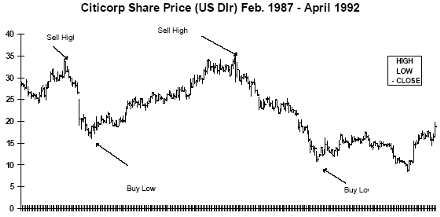A position can only be closed if there is an open position. A position is closed if there is a high probability of a reversal or ending of a trend.
a. Stop/Take Profit rule
This rule can only be generated when a position (either long or short) has been opened. It is generated when indicators show a high probability of a reversal in trend or a contrary movement of the security price to the open position. It can also be generated if the price of the security hits a certain level thus causing the threshold level of loss tolerance to be triggered. Systems that set a profit-taking target when a position is open call the closing position rule, a take-profit rule, while systems that place stops on an open position call the closing position rule a stop loss rule.
Chart 4-1 is an example of the technical charts analyzed by traders for pattern formations such as head and shoulders, triangles, and trend lines. The main components of the chart are the high, low and closing price of the security plotted against time. Sometimes the opening price and volume of transactions completed are also plotted. For a profitable trade to be made, it is obvious that one needs to buy when the price has bottomed out and sell when the price has topped out.
Chart 4-1 A Typical Technical Price Chart

Selection of Indicators/Data Input to ANN
The selection of technical and economic indicators/data to be used will depend on the following factors:
i. Availability: The data must be easily obtainable.
ii. Sufficiency of the historical databases: There must be enough sample data for the ANN learning and system testing process.
iii. Correlation of the indicators to the price: The data should have some relevancy to the price of the security (whether it is lagging, leading, coincidental or noise).
iv. Periodicity of the data: The data must be available in a predictable frequency ( quarterly, monthly, weekly, yearly).
v. Reliability of the data: The fast changing pace of today’s global financial world and the increased in financial market volatility has resulted in difficulty to obtain reliable economic data. This results in economic bodies having to frequently revise their data. Thus, if a price forecasting model is built on revised historical input data, the model’s immediate forecast may not be reliable as the new data that is fed into the model will probably be erroneous.
Two sets of historical data are used. The first set is used to train the ANN to develop trading strategies and generate rules. The second set is used to test the profitability and reliability of the system. The system developer must be careful not to use the second set as training data inadvertently by modifying the system if it performs badly on the second set of data.
Prof. Clarence N W Tan
Next: Books Related
Summary: Index